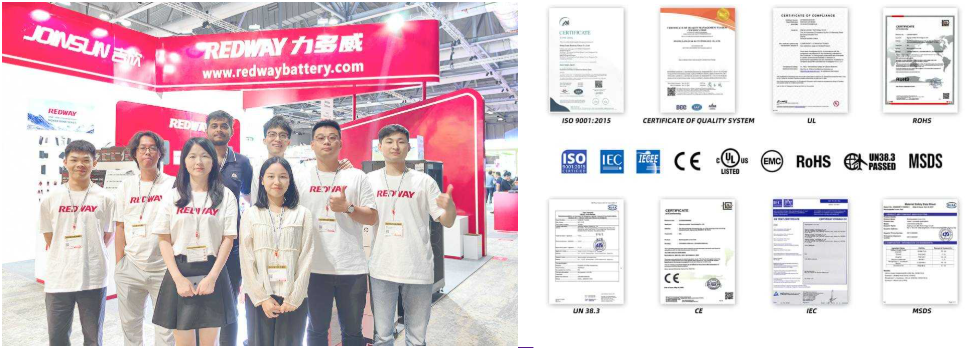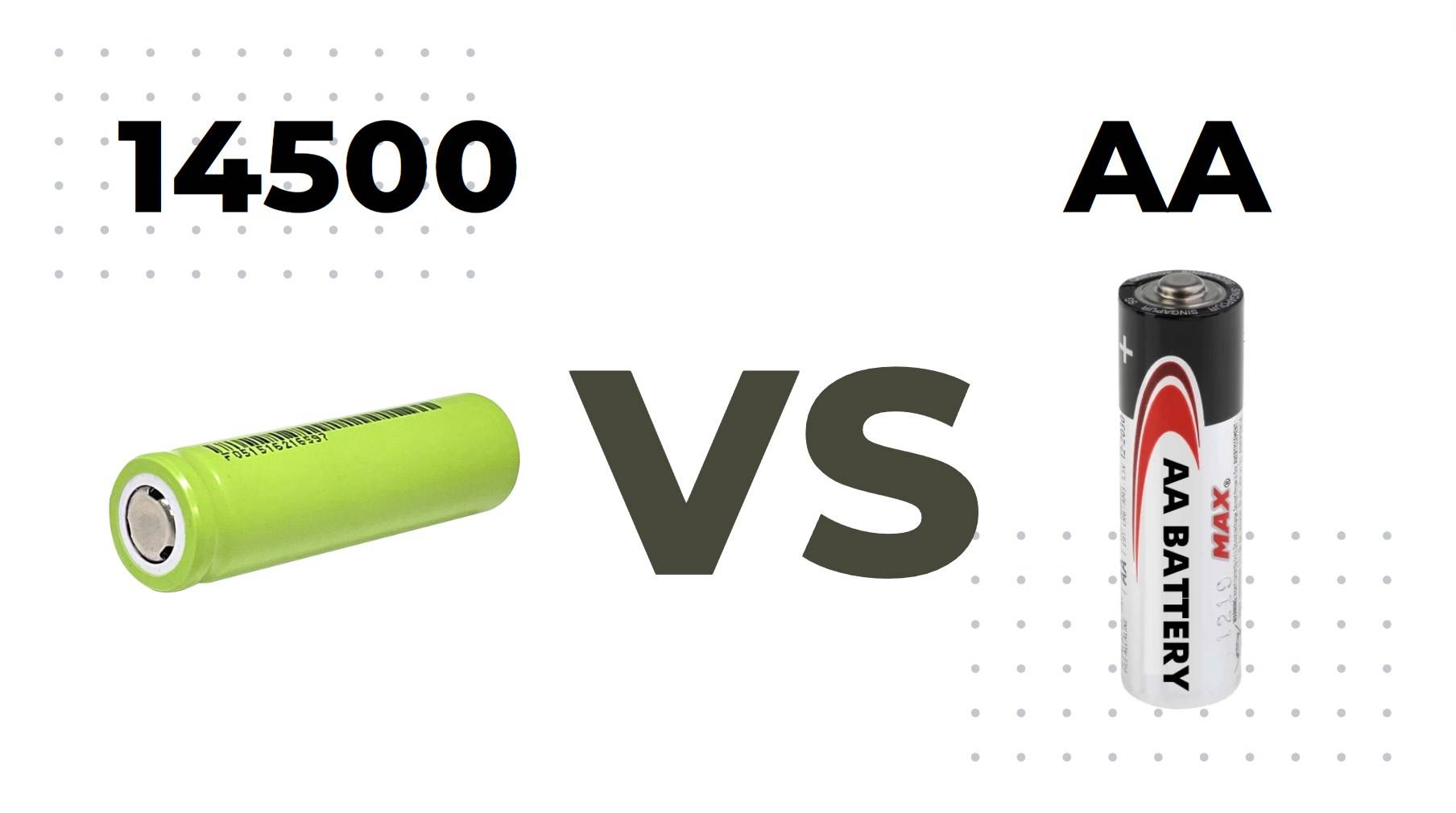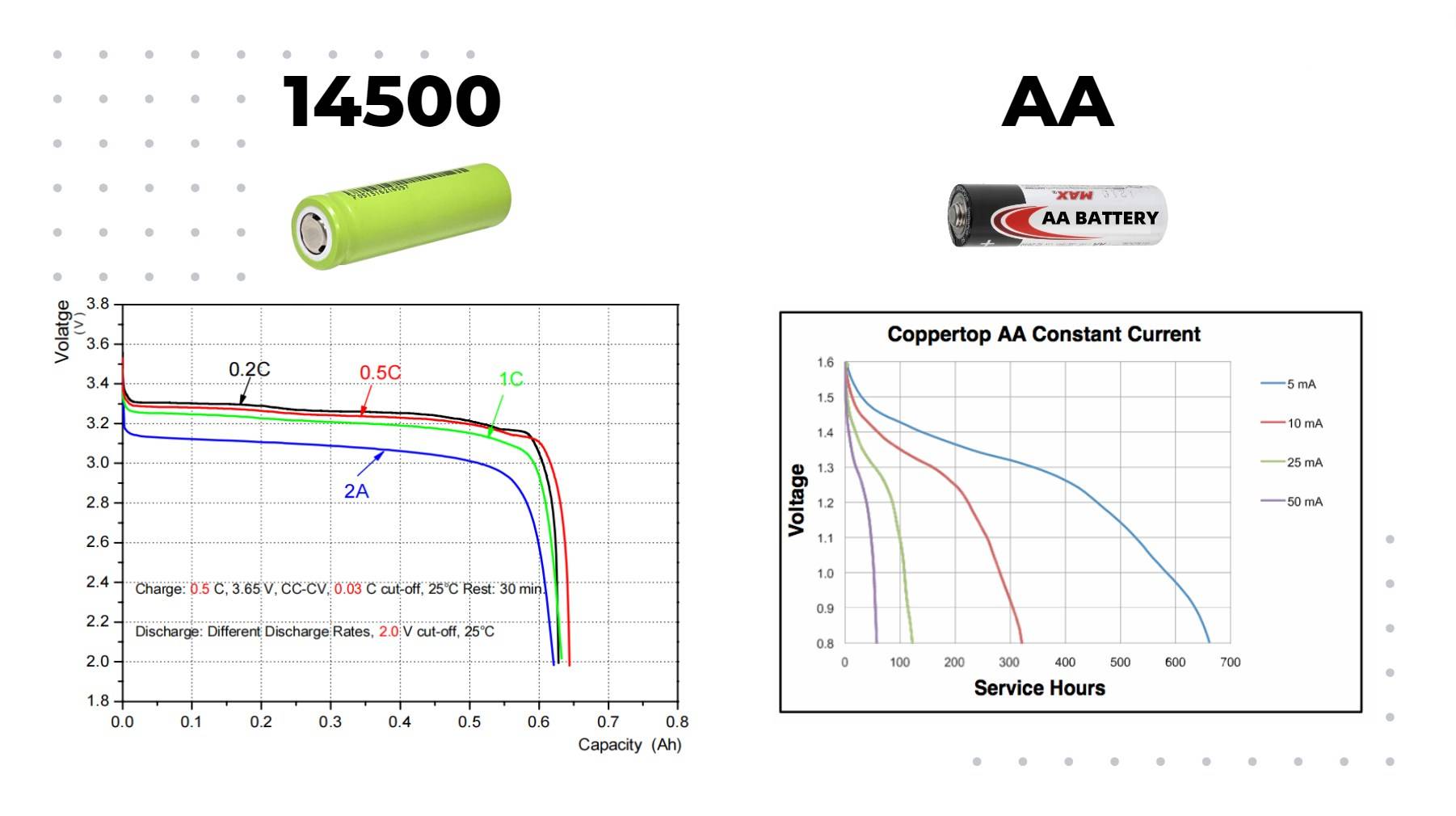The comparison between 14500 and AA batteries reveals significant differences in size, voltage, and performance. The 14500 battery, a rechargeable lithium-ion cell, typically delivers 3.7 volts, while standard AA batteries provide 1.5 volts (alkaline) or 1.2 volts (NiMH). Understanding these differences can help you choose the right battery for your needs.
What are the key differences between 14500 and AA batteries?
The 14500 and AA batteries share a similar cylindrical shape but differ in several key aspects:
- Size: The 14500 battery is slightly taller than a standard AA battery, which can affect compatibility with devices designed for AA batteries.
- Voltage: The nominal voltage of a 14500 battery is approximately 3.7V, compared to 1.5V for alkaline AA batteries and 1.2V for NiMH rechargeable AA batteries.
- Chemistry: The 14500 uses lithium-ion chemistry, while AA batteries can be alkaline, NiMH, or lithium-iron.
Chart: Key Differences Between 14500 and AA Batteries
| Feature | 14500 Battery | AA Battery |
|---|---|---|
| Size | Slightly taller | Standard size |
| Voltage | 3.7V | 1.5V (alkaline) / 1.2V (NiMH) |
| Chemistry | Lithium-ion | Alkaline / NiMH |
How does voltage affect battery performance?
Voltage plays a critical role in determining how well a battery performs in various devices. The higher voltage of the 14500 battery allows it to power devices that require more energy, making it suitable for high-drain applications like LED flashlights and power tools. In contrast, devices designed for standard AA batteries typically operate at lower voltages, which means substituting a 14500 for an AA could damage those devices.
What is the lifespan of 14500 vs. AA batteries?
The lifespan of these batteries varies significantly based on their chemistry:
- 14500 Battery: Typically lasts around 300 to 500 charge cycles, depending on usage.
- AA Batteries: Alkaline AA batteries are single-use, while rechargeable NiMH AA batteries can last between 500 to 1000 cycles.
In terms of overall lifespan, rechargeable options tend to provide better value over time, especially in high-use scenarios.Chart: Lifespan Comparison
| Battery Type | Lifespan (Cycles) |
|---|---|
| 14500 Lithium-ion | 300 – 500 |
| Alkaline AA | Single-use |
| NiMH AA | 500 – 1000 |
Which battery is more cost-effective over time?
While the initial cost of a 14500 battery is generally higher than that of standard alkaline AA batteries, its rechargeability can make it more cost-effective in the long run if used frequently. Alkaline batteries are cheaper upfront but need to be replaced after use, which can add up over time.When evaluating cost-effectiveness, consider both purchase price and expected lifespan based on your usage patterns.
What are the best applications for each battery type?
Choosing between a 14500 battery and an AA battery largely depends on your specific application:
- 14500 Battery: Best suited for high-drain devices requiring higher voltage and energy density, such as LED flashlights, digital cameras, and some smart home devices.
- AA Batteries: Ideal for low-drain devices like remote controls, clocks, and toys where longer runtime at lower voltages is sufficient.
Expert Opinions
“Selecting the right battery type hinges on understanding your device’s requirements,” says Dr. Emily Chen, an energy storage expert. “While the higher voltage of the 14500 makes it suitable for demanding applications, traditional AA batteries still hold their ground in everyday consumer electronics.”
Conclusion
The comparison between 14500 and AA batteries highlights essential differences in size, voltage, chemistry, lifespan, and application suitability. Understanding these factors enables consumers to make informed choices based on their specific needs.
Frequently Asked Questions
- Can I use a 14500 battery instead of an AA battery?
Generally no; using a 14500 may damage devices designed for lower voltages unless specified. - Which type lasts longer in low-drain devices?
Alkaline AA batteries are preferable in low-drain applications due to their longer shelf life. - Are both types rechargeable?
Only the 14500 lithium-ion and NiMH rechargeable AA batteries are rechargeable; alkaline ones are not. - How do I know if my device can handle a higher voltage?
Check the device specifications; if it lists compatibility with lithium-ion or higher voltages, it may work. - What should I consider when choosing between these batteries?
Consider device requirements (voltage), usage frequency (cost-effectiveness), and whether rechargeability is important.
Why Opt for 18650 Over 14500 Batteries?
The 18650 battery is preferred over the 14500 due to its higher capacity, typically ranging from 1800mAh to 3500mAh, making it suitable for high-drain applications. Its larger size allows for better energy storage and discharge rates, which are crucial for devices requiring sustained power, such as electric vehicles and high-performance electronics.
Why the 18650 Battery Stands Out for Versatility
The versatility of the 18650 battery stems from its wide range of applications, including laptops, electric vehicles, and power tools. Its ability to deliver high discharge rates and long-lasting power makes it ideal for both consumer electronics and industrial uses, setting it apart from smaller batteries like the 14500.
What’s the Usual Capacity of 18650 Batteries?
The typical capacity of 18650 batteries ranges from 1800mAh to 3500mAh, depending on the specific model and manufacturer. This high capacity allows them to support a variety of devices, providing longer run times and making them suitable for applications that demand consistent power delivery.
How Are 18650 Batteries Unique in Specs and Use?
18650 batteries are unique due to their cylindrical shape (18mm x 65mm), high energy density, and ability to handle high discharge rates. They are commonly used in high-performance applications like electric vehicles and power banks, offering advantages in both size and energy output compared to smaller batteries like the 14500.
How Do 18650 and 14500 Batteries Compare?
When comparing the two, the 18650 battery has a larger capacity (up to 3500mAh) versus the **14500’s maximum of around 1200mAh. The dimensions also differ significantly; the 18650 is larger, allowing it to store more energy. Both operate at similar voltages (approximately 3.7V) but serve different application needs based on size and capacity.
What Are the 18650 Battery’s Dimensions?
The dimensions of a standard 18650 battery are approximately 18mm in diameter and 65mm in length. This cylindrical shape allows it to fit into various devices while providing substantial energy storage compared to smaller batteries like the 14500, which measures 14mm x 50mm.
What Defines the 18650 Battery’s Key Traits?
Key traits of the 18650 battery include its high capacity (up to 3500mAh), ability to deliver high discharge rates, and long cycle life. These characteristics make it suitable for demanding applications like electric vehicles, laptops, and power tools, where reliability and performance are essential.
Why Is the 14500 Battery So Compatible?
The 14500 battery’s compatibility stems from its similar size to AA batteries, making it suitable for a wide range of devices designed for standard alkaline batteries. Its compact design allows it to fit into smaller electronics without sacrificing performance, making it a versatile choice for portable applications.
How Wide Is the 14500 Battery’s Capacity Range?
The capacity range of 14500 batteries typically falls between 600mAh and 1200mAh, depending on the specific model. While this lower capacity limits its use in high-drain applications compared to the 18650, it remains effective for devices requiring less power, such as small flashlights and remote controls.
How Does 18650 Battery’s High Discharge Rate Benefit Usage?
The high discharge rate of the 18650 battery, often reaching up to 10C, allows it to provide bursts of power needed for demanding applications like power tools and electric vehicles. This capability ensures that devices can operate efficiently without overheating or losing performance during intensive use.
What are Key Applications of the 18650 Battery?
Key applications of the 18650 battery include powering laptops, electric vehicles, drones, power banks, and portable electronics. Its versatility makes it suitable for various industries, including renewable energy storage systems and medical devices, where reliability and performance are critical.
What is Typical Capacity Range of the 18650 Battery?
The typical capacity range of the 18650 battery spans from approximately 1800mAh to 3500mAh, depending on chemistry and manufacturer. This wide range allows users to select batteries that best meet their specific energy needs while ensuring optimal performance across various applications.
How to Decide Between 18650 and 14500 Battery for Device?
To decide between an 18650 and a 14500 battery, consider your device’s size requirements, power consumption needs, and desired run time. If your device requires higher capacity or discharge rates, opt for an 18650 battery; if space is limited or lower power is sufficient, a 14500 battery may be more appropriate.
What Unique Features Make 18650 and 14500 Batteries Suitable for Different Apps?
Unique features that make these batteries suitable for different applications include the 18650’s higher capacity, which supports demanding devices like electric vehicles, while the **14500’s compact size makes it ideal for portable electronics. Both types share similar voltage characteristics but cater to distinct user needs based on performance requirements.







